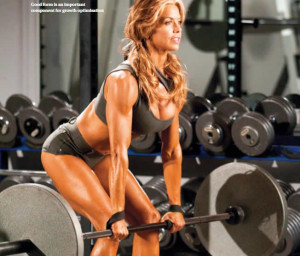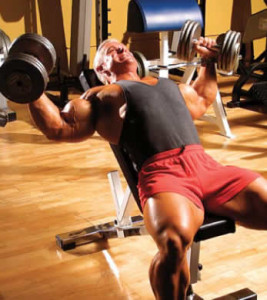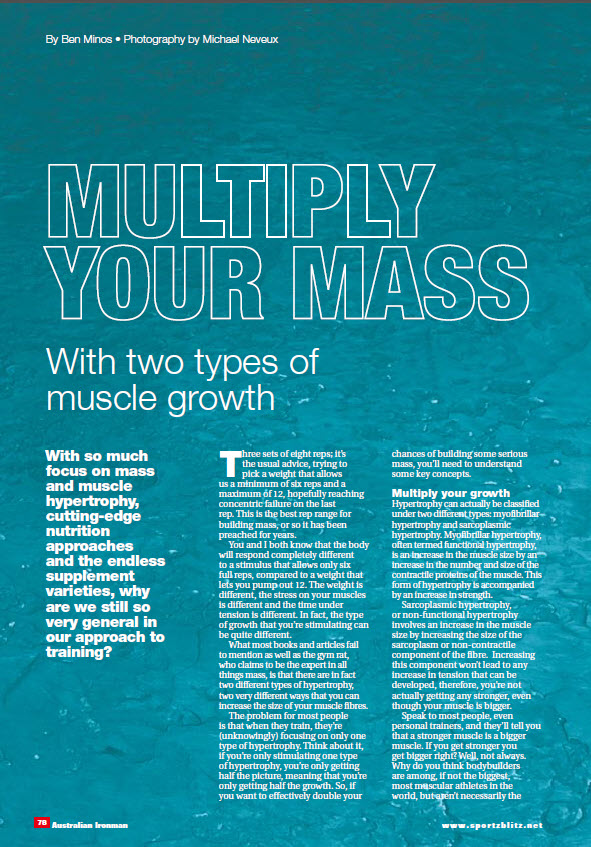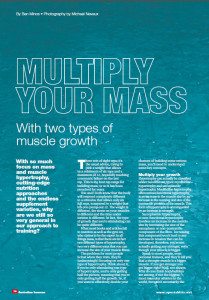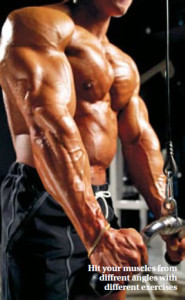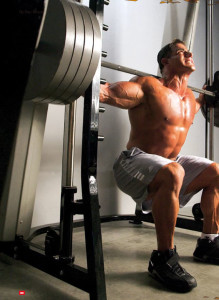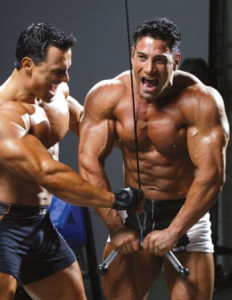Is Muscle Shaping Possible?
(Australian Ironman magazine article by Ben Minos – click here to view PDF of actual article)
Concentration Curls for bicep peaks? How about stretch position exercise for a longer select that muscle belly? Is it really bodybuilding myth, all can we actually change the shape of our muscles?
Modern science has you believe that genetics is the only factor determining muscles shape. Truth is we don’t really know how or why muscle growth occurs. Our knowledge and understanding of the pathways involved has grown considerably in recent times, but ultimately, the area of muscle growth is still poorly understood. Could it be that our lack of understanding has blinded us from some
effective training methods and techniques that could help us reach our full potential? For muscle shaping to be possible, we need to understand and accept a few key notions.
Hypertrophy versus hyperplasia?
The heading should actually read hypertrophy plus hyperplasia equals growth. It has long been accepted that muscle growth can occur through hypertrophy (an increase in size of the individual fibre),
and for a long period it was thought that this was the only mechanism through which growth occurred. There is, however, substantial evidence that hyperplasia (an increase in fibre number) occurs, and maybe more prevalent (especially in body builders) than what we once thought.
Several studies have looked at the occurrence of hyperplasia not only in humans, but in animals as well. You may have heard by now the infamous Jose Antonio study in which a weight was attached to
the wing of a bird. This study had been completed before, but Antonio’s model differed from the previous models in that his weight was then progressively overloaded. The total number of stretch days
was 28. Using this approach, Antonio managed to achieve the greatest gains in muscle mass ever recorded in an animal or human model of tension induced overload. Not only was there are 334 per cent increase in muscle mass, but up to a 90 per cent increase in fibre number. Dr. Jose Antonio has completed his doctorate in this area and has been at the forefront in research regarding hyperplasia.
He also points to another study that showed that elite body builders and power lifters had upper arm circumferences 27 per cent greater than normal sedentary controls, although the cross sectional area of their triceps muscle fibers were not different from the control group. Yet another study showed that bodybuilders displayed thigh circumference measurements 19 per cent greater than that of control
subjects, yet the average size of their muscle fibers were not significantly different from the controls. Some researchers counter these findings by suggesting that many bodybuilders or other athletes have the same sized or smaller muscle fibers verses untrained controls is because of greater genetic endowment of muscle fibers. In other words, they must have been born this way. Antonio points out that, if this were true, then the prolonged periods of intense training performed by elite body builders and other strength athletes has produced at best average size muscle fibers.
More research found that swimmers deltoid muscles were greater in size than the controls, even though they had smaller type 1 and IIA muscle fibers. There has been significant research conducted involving direct counts of muscle fibers and they have also shown that both exercises and stretch overload result in significant increases in the number of muscle fibers. The real question then is not whether or not hyperplasia occurs but under what circumstances doesn’t occur? The first assumption on our pathway to muscle shaping: hyperplasia is real and does occur in the human body. Especially in body builders. We don’t as yet understand why or how it occurs, but there is substantial evidence to support its existence. It is, therefore, reasonable to assume that hypertrophy is not the only mechanism at play, but can also occur with concurrent hyperplasia of muscle fibers.
The Structure of Muscles
An extremely important, but often surprising fact is that individual muscle fibers rarely run the entire length of a muscle. Your muscle belly is actually made up of a sequence of 2.5 to 10 centimetres (one to four inch) segments of muscle fibres linked together. If hyperplasia occurs through the splitting of a cell and then the proliferation of a fibre, what would happen if the hyperplasia were to be concentrated in one specific region of the muscle belly? The muscle fibers found in the middle of the muscle belly and the same as those found at the ends. What if some of the fibres in the middle of the muscle belly underwent hyperplasia? Would they magically migrate to another region of the muscle or spread themselves out evenly amongst the other fibres? No. They were pretty much split and stay in the same area as where they started. The second point that is critical in understanding how changing your muscle shape can occur is that you can’t simply think of muscle fibres as being synchronous with the actual muscle itself.
Form Follows Function
Another key concept is to understand that a muscle’s structure will always follow it’s function. For years it has been understood that neural adaptations in strength are highly specific to the activity being performed. Why are your physiological or muscular adaptations any different? The S.A.I.D. principle gets thrown around often enough. That is Specific Adaptations to Imposed Demands. Well, how about specific growth occurring in key muscle fibres in response to specific joint angles, muscle lengths and tension demands of the exercise being performed? It’s been shown that the motor units, and subsequent muscle fibres, being hit by one exercise (for example the squat) are not the same motor units and fibres being targeted by another exercise (such as the leg extension). This is why it is encouraged practise by bodybuilders to hit a muscle from a variety of different angles in order to the fullest muscular development. If this wasn’t the case, you would only ever have to do one exercise for each body part to failure in order to get total muscular development. Ironically, this is already the accepted way of training muscle groups such as chest, where we know that if you exercise on an incline, this shifts the emphasis to the upper fibres. Is it unreasonable then to predict that you can emphasise different aspects of other muscles in the body depending on what angle and position you hit it? For example a shortened position for extra demands on the biceps muscle belly?
A cell has the capacity to alter it’s shape as well as it’s volume in response to a need for altered force production. Muscle cells are no different. Unfortunately, to date, little research has been conducted addresssing the questions of cell shape or regional growth.
Does Growth of Fibres Happen in Series or Parallel?
One thing we do know, however, is that a cell’s shape is regulated by work. Remember, a muscle cell is three dimensional; therefor, a cell is abel to double it’s volume either in width or in length. The addition of sarcomeres end to end in series makes the cell longer, whereas the addition of sarcomeres side by side in parallel makes the cell wider.
Again, little research has been done in this area, but, judging by how growth is governed in the rest of the body, we may be able to assume that growth in series and/or parallel may occur, depending on the demands placed on the muscle and the special circumstances in which they occur.
How is Muscle Shaping Possible?
So, what does all of this mean as far as muscle shaping goes? In order to change the shape of a muscle we have to remember:
- sufficient evidence for hyperplasia exists
- muscle fibres are short and are not synchronous with the whole muscle belly
- a cells shape is regulated by work
- growth may happen in series and/or parallel
According to the sliding filament theory, when a muscle shortens beyond it’s optimal length, there is overlap of the contractile units leading to a situation where not as many cross bridges or linkages are able to form. This leads to a decrease in the amount of tension able to be developed and a subsequent loss of muscle force in these positions. This is one of the reasons why you are weaker near the top of a lying leg curl; the hamstrings are in a shortened position.
Adding Peak
How does your body then adapt to produce more force in these shortened positions (neural adaptations aside)? By adding more fibres in the region where the tension demands are greatest of course! Take the concentration curl for example. In this exercise the muscle is in a shortened position, so, as you move through the range of motion, the tension demands are the greatest in the middle of the muscle belly. And, what does it mean to have your body add more fibres ‘in parallel’ in the area where more force production is being demanded? Why you would end up with a bigger biceps peak of course!
Even if hyperplasia wasn’t possible, your body would still preferentially increase the myofibrillar density in the actual fibres where the demand for force was the greatest. Remember that some fibres are only a few cm’s in length. Well the fibres that are concentrated around the centre of the muscle belly would get preferential hypertrophy. Better yet, what would happen if both occurred at the same time? A mix of both hypertrophy and hyperplasia? this is actually the more likely scenario as there is sufficient evidence to support that both occur, especially in bodybuilders.
The key to remember is that adaptation is specific to the area of the muscle where the tension demand is most concentrated. Your body will increase the myofibrillar density (increase fibre size) in the fibres that are congregated around this area, or, will add new fibres (in series and/or parallel) specifically around this critical zone (hyperplasia). With each fibre only being a few cm’s in length, this can change the shape of the overall muscle, So, biceps peakm here we come.
Adding Length
What about stretch position exercises? A similar phenomenon occurs when the muscle is lengthened beyond it’s optimal position. You’re left with a situation where too few cross-linkages are to form because now they are too far apart. So, lengthening the fibres beyond their max position, not enough cross-linkages can bind to generate adequate force. How does your body adapt this time? How about the area of greatest stress i.e. at the ends of the muscle belly, aka the musculotendinous junction? More fibres added at the ends and what does this create? A fuller, longer muscle. There is already evidence to suggest that it is more the eccentric component and stretch position that favours hyperplasia. And it makes sense that this proliferation of cells happens at each end.
The key to this theory is that adaptation will occur more focally and specifically in the area where the tension developed/demanded is greater. In the instance of a shortened muscle, this would be nearer to the centre of the muscle belly. Your body becomes stronger and more efficient at developing tension in this position through hypertrophy and/or hyperplasia of the muscle fibres that congregate in this region of the belly, thus giving you more of a peak, aka biceps peak, from exercises such as concentration curls.
In the case of the lengthened position, where the tension tends to be greater nearer the ends of the muscle belly, at the musculotendinous section, yuor body adapts by the addition of myofibrils and even brand new fibres at these critical zones. What’s the adaptation? A longer, fuller muscle.
This has also been shown in a study where stretching a rabbit’s leg made the mRNA accumulate at the tips of the elongating fibres as they grew longer.
The truth is we don’t know the exact mechanisms or conditions in which muscle groth occurs. We also don;t know if this growth is series or in parallel and what unique mechanisms, if any, stimulate which. As with everything else in the body, form will follow function, so one day we may find that hypertrophy and hyperplasia may be specific to certain demands places on a muscle and regionally specific to these demands.
There is no question as to the importance of genetics in determining muscle size and shape. But that doesn’t mean we don’t possess the potential to change and adapt to enviroment stimuli.
Weight training may provide that special stimulus that allows us to indeed change the shape of our musculature. You may never get the biceps peak of an Arnold, but you may want to give him a run for his money.
References:
Antonio, J. (1997) Muscle Fibre Hypertrophy vs. Hyperplasia Has the Debate been Settled? http://home.hia-no/~stephens/hypplas.htm
Russell, B, et al (2000). Form follows Function: how muscle shape is regulated by work, Journal of Applied Physiology 88:11127-1132.
Siff, M.C. (2003) Supertraining, 6th edition, Supertraining Institute, Denver USA
Stoppani, J (2006) Encyclopedia of Muscle & Strength, Human Kinetics, USA
Editor’s note: Ben is a physiotherapist and exercise physiologist. He owns a personal training business that specialises in Kettlebell Training, Bodybuilding & Nutrition.,


